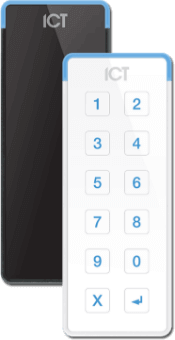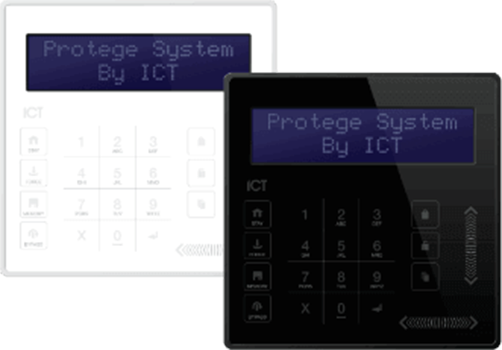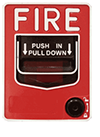Video MGMT System
 Access Control
Access Control
Voice & Data Wiring
 Burglar Alarm
Burglar Alarm
 Fire Alarm
Fire Alarm
Video MGMT System
Voice & Data Wiring
THOUGHT CENTER > Blog > Access Controls
September 27, 2023
Too busy to read? Here’s a summary:
With advancements in technology, door access control systems have evolved from simple locks and keys to sophisticated electronic devices that offer many security and convenience features.
But what exactly is door access control, and why is it so needed these days?
Keep on reading to unlock the secrets of door access control.
Door access control systems are designed to restrict access to specific areas of a building or property. They use a combination of hardware and software products to authenticate user identities before granting or denying entry based on predefined criteria.
The heart of door access control systems lies in the credentials they use and the door readers that authenticate them.
Magnetic stripe cards, often referred to as 'swipe cards,' have a magnetic stripe on the back, similar to credit cards. This stripe stores the user's data.
When the card is swiped through a reader, the reader decodes the information on the stripe to identify the card user.
Proximity cards, or 'prox cards,' contain an embedded antenna that communicates with the door reader without making direct contact.
When a proximity card is brought close to a reader, the embedded antenna transmits the card's information to a door reader using near-field communication (NFC) or radio frequency identification (RFID) signals.
Smart cards look similar to credit cards but have an embedded microprocessor chip that can store more data than chips used in standard access cards.
This microprocessor chip communicates with door readers either through direct contact or proximity, depending on the card's design.
With the rise of smartphones, mobile credentials have become increasingly popular. They turn a user's smartphone into an access card.
Using apps and Bluetooth or NFC technology, the phone communicates with the door reader to initiate an access attempt.
Biometric access control systems capture unique biological characteristics (like fingerprints and iris patterns) to identify individuals.
A user's biometric data must first be enrolled into the system. When access is attempted after enrollment, the system will compare presented biometric data with stored data to authenticate users.
Beyond just security, most door access control systems offer a wide range of benefits:
Modern door access control systems can seamlessly integrate with other security systems like CCTV cameras, alarm systems, and fire safety systems.
With the advent of cloud technology and Internet Protocol (IP) devices, many systems now allow users to control and monitor access privileges remotely.
Modern systems can be programmed to provide customized access for individuals, thereby ensuring that people have access only to the areas they need.
Door access control systems eliminate the need for security personnel at every entry and exit point. Automating entry protocols results in significant savings in manpower and its associated costs.
These systems automatically record every access attempt, successful or not. They provide a timestamped log of who entered or exited and when. This log offers organizations a clear audit trail, making it easier to review and analyze entry patterns, detect unauthorized access attempts, and comply with industry-specific regulations like HIPAA.
With many different brands and approaches to door access control, choosing the right system can be daunting. Here are some factors to consider:
Size of the Premises: A large corporate office might require a more sophisticated system than a small retail store.
Budget: While security is paramount, it's essential to find a system that fits within your budget.
Future Expansion: Consider whether the system can be easily expanded or upgraded in the future.
Integration Capabilities: Ensure the door access control system you select for installation can integrate seamlessly with other existing or future security and tech systems, like CCTV and smart systems for building management.
Ease of Use: A system that's intuitive and user-friendly ensures that employees or residents can use it without constant training or support. This will help to avoid user and administrative errors that may cause inconvenience or reduce the system’s effectiveness.
Durability: Choose a system that can withstand daily wear and tear and adverse conditions, especially if it's installed outdoors.
Support: Consider the kind of after-sales support the vendor provides. Opting for systems where timely maintenance, software updates, and customer support are readily available is beneficial.
Every system has its challenges, but with proper knowledge, these challenges can easily be overcome.
Lost or Stolen Credentials: Instantly delete site authorizations connected with lost or stolen credentials. Then audit the access logs to make sure the lost or stolen credential has not been used by an unauthorized user to access sensitive areas and information.
Tailgating: Install turnstiles or security cameras at entry and exit points.
System Failures: Regular maintenance and software updates can prevent most system failures.
When it comes to safeguarding your premises, why settle for anything less than the best? Mammoth Security has cemented its reputation as Connecticut's premier security solutions provider, offering a comprehensive range of services from access control systems to fire alarms and structured cabling.
Our expertise is unparalleled, and our commitment to your safety is unwavering. Take the first step toward a safer tomorrow by filling out the form below today! We’ll quickly contact you to schedule a 100% free, zero-obligation site survey and security assessment with a friendly Mammoth Security expert today.
NOT COMPLETELY SURE?
860-748-4292Yes, most modern systems offer integration capabilities with existing security systems.
Biometric access control systems are among the most secure because they rely on unique physical characteristics to identify individuals. However, like all systems, they are not entirely foolproof.
Most systems have backup power sources or batteries to ensure they remain operational during power outages.
Yes, most access control systems offer remote control and remote monitoring via a desktop or smartphone application.
Regular software updates are crucial for access control door security. Check for updates at least once a month.